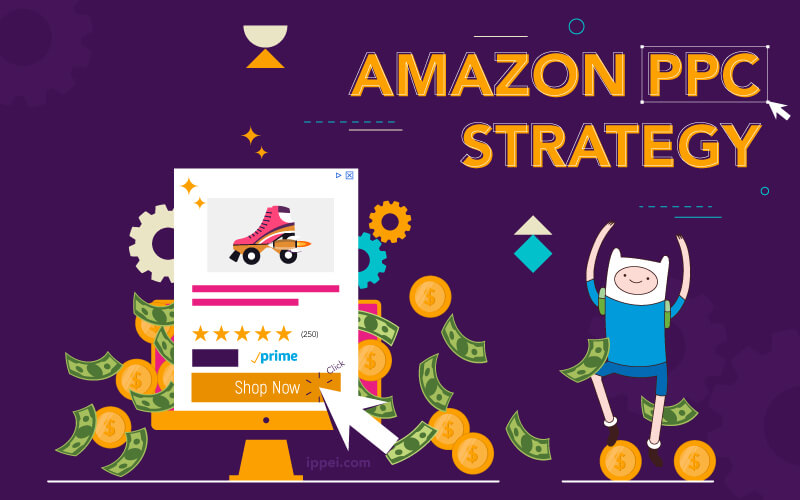
According to Ad Badger, the average cost of someone clicking on an Amazon advertisement is $0.89.
Despite cutting into profit margins, Amazon PPC is an integral piece of every successful Amazon seller’s business strategy.
Unlike Google ads or Facebook ads, an Amazon PPC ad appears naturally as a search result through the very medium that customers are searching to make purchases.
There are ultimately three primary goals of any Amazon PPC strategy:
- Generate higher sales to move up in keyword ranking so you can make more organic sales
- Obtain reviews through higher sales to improve social perception of product and brand
- Drive profitability by optimizing campaigns to leave a generous profit margin after advertising costs
Since every business is different, there is no one size fits all approach to Amazon advertising.
Establishing an Amazon PPC strategy specific to your business can be challenging. If you have been struggling, you are certainly not alone. According to Jungle Scout, 42% of Amazon sellers cite PPC ad spend as one of their greatest challenges.
However, with the tips and tricks outlined in this Amazon PPC guide, you will soon be on your way to improving your Amazon advertising results!
Before diving in, make sure you have some fundamental terminology down.
Terminology
PPC, or pay-per-click, advertising means that you only pay for advertisements that are actually clicked into. You pay nothing if your advertisement is viewed but not clicked into for further details.
A campaign is where all the details for a campaign are set. This is where you organize your ads and targeting preferences.
Ad groups allow you to organize and manage ads within a campaign. Within an ad group, you can organize by product, category, price range, etc.
A search term is the word or phrase that a customer types into the search bar when looking for an item.
A keyword is a word or phrase that marketers set to target customer search terms.
When a marketer sets a keyword in their campaign, their advertisement triggers when a potential customer types in a matching or relevant search term.
Amazon PPC is an auction based advertising model. Advertisers outline the amount of money they are willing to spend to have their ad show in specific situations.
This is the primary indicator of ad spend performance, as it is the ratio of ad spend to sales. It shows you the percentage cost of sales made with advertisement.
For example, if you receive $500 because of clicks made through a campaign but only spent $100 on those ads, your ACoS is $100/$500 = 20%.
The break-even ACoS = Profit Margin
Therefore, if your ACoS is greater than your profit margin, you are losing money.
Use the Search Term Report

You have access to a few different reports through your Amazon seller central account, but the most useful data for optimizing your campaigns is found on the Search Term Report.

This report shows the performance of different search terms across campaigns with the metrics you need to make optimization decisions.
With the Search Term Report, you can identify the search terms that are efficiently generating sales and those that are performing poorly. It provides the valuable data for campaign optimization.
Amazon guru Tim Sanders suggests reviewing this reports weekly.
Broaden Your Reach with Various Campaigns
As an Amazon seller, you have access to three Amazon Sponsored ad types, including:
- Sponsored Product Ad
- Sponsored Brand Ad
- Sponsored Display Ad
Sponsored Product Ad
Sponsored products ads are by far the most common form of PPC ad used by Amazon sellers. They appear in search results and on product listing pages and are a great way to position individual products in front of potential customers.
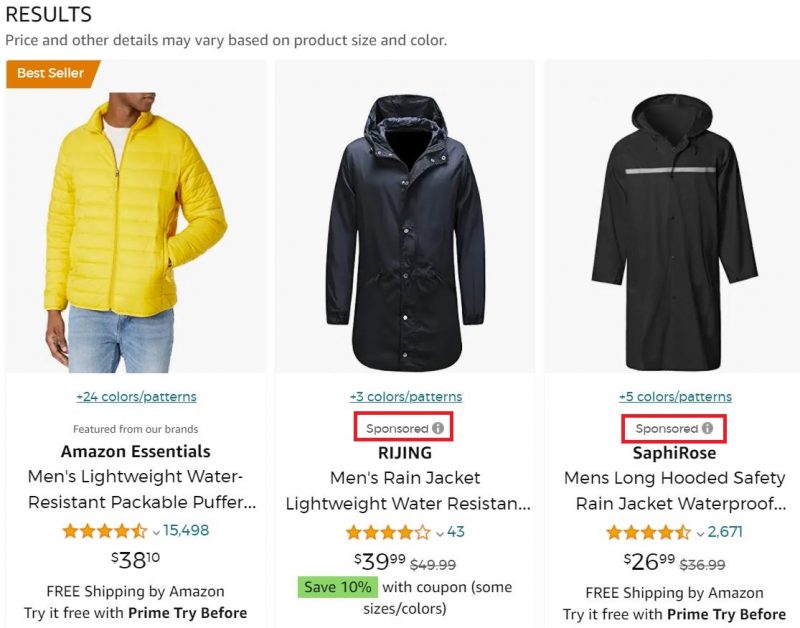
There are two types of Sponsored Product campaigns you can run:
Automatic Campaign
Automatic campaigns are not only useful for PPC newbies, but are also a powerful research tool that should be incorporated into your strategy no matter your experience level.
In an automatic campaign, Amazon has full control over choosing the campaign’s target keywords by using the content of your product listing and related customer searches. Good Amazon SEO practices are essential here.
Automatic campaigns extend your reach through cheaper bids than manual campaigns, while supplying valuable keyword data for manual campaigns.
Manual Campaign
Manual campaigns are where adjust and fine tune your marketing efforts to promote more efficient campaigns with lower long-term ad spend.
You can elect to target your advertisements either by keywords or products in a manual campaign.
Keyword Targeting
Amazon sellers use keyword targeting to bid on specific keywords. Before creating a keyword targeting campaign, you need to do keyword research to compile a list of keywords that the campaign will target.
You can choose to target by broad, phrase or exact match keywords. Each has their own purpose and benefits in an Amazon PPC strategy.
Keyword bids become more expensive the more specific they become.
This type of targeting spends on any variations of the main keyword. These keywords are least expensive to bid on.
Ex: Dish Holder = Dish Holders, Dish Soap Holder, Metal Dish Holder, Dish Holder
This type of targeting spends only on variations that include the exact keyword.
Ex: Dish Holder = Dish Holders, Dish Soap Holder, Metal Dish Holder, Dish Holder
This type of targeting spends when the keyword is the only term searched. These keywords are most expensive to bid on.
Ex: Dish Holder = Dish Holders, Dish Soap Holder, Metal Dish Holder, Dish Holder
Product Targeting
With Product Targeting, you can either target individual products by using their ASIN or target by product category.
ASIN targeting allows you to target specific products. You can direct your advertising to either appear or not appear on a specific product listing page.
Category targeting allows you to place ads on products in specific categories of your choice. You can refine your search with specific brands, star ratings, price range and more.
Sponsored Brand Ad
Amazon Sponsored brand ads (known formerly as headline search ads) can take a few different forms. They appear either at the top of the search results page as a headline banner or lower on the page as a video.
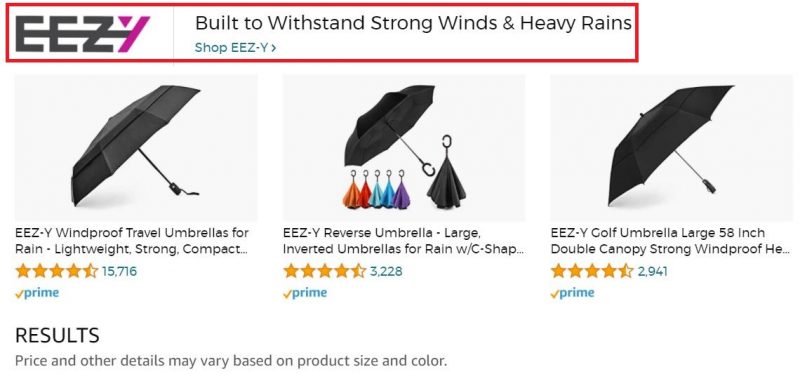
It’s easy to understand why being the first search result at the top of the page is a tremendous benefit.
Similar to Sponsored Product ads, you can use either keyword or product targeting to position your ads.
Sponsored Display Ad
Unlike Sponsored Product and Sponsored Brand ad types, Sponsored Display ads allow an Amazon seller to expand their reach beyond Amazon’s website.
These ads appear on Amazon’s affiliate sites like Google, Facebook and even mobile applications.
The purpose of these ads is to re-target customers who have already showed product interest by visiting your product's page.
Of these three ad types, Sponsored Products is the only one available to all Amazon FBA sellers.
In order to use the Sponsored Brand or Sponsored Display ad type, you must register your brand with Amazon.
It’s impossible to predict which advertising setup is going to be optimal for a given product.
Amazon PPC strategy requires regular testing across different campaign and ad types until you find what works for your specific product and market.
Separate Auto Campaigns
There are four targeting groups you can set in an auto campaign:
- Close Match
- Loose Match
- Complements
- Substitutes
To maximize control, separate the four targeting groups into their own campaigns.
This allows you to test and fine tune each separately, as each targeting group will require a different bid amount for optimal performance.
When you put all four targeting groups in the same auto campaign as is the common practice, if one targeting group is doing well but the others are not, you cannot scale your budget efficiently to take advantage of the group performing well because the ad budget is spread over all four groups.
If you separate them, you can scale the budget only on the group doing well. Then, continue testing on the other groups until they test well and you can scale them too.
PPC Pyramid Flow
You can incorporate the use of a PPC pyramid style flow to move high performing search terms along into more specific targeting types to optimize ad spend on campaigns.

Establish rules for moving search terms from lower bid cost, broader baskets to higher bid cost, more specific baskets as they prove their performance over time.
Within a campaign, create an ad group for each keyword match type.
Example: Ad Group: Broad Ad Group, Ad Group: Exact Ad Group
Some suggestions to get you started:
Auto -> Broad:
At least two sales recorded from keyword. One sale could just be chance, but two or more is a stronger sign of the keyword’s ability to convert.
Don’t look at any other metrics at this stage, just look for sales ability.
Broad -> Phrase:
- Profitable ACoS
- 10-20 clicks
- 3-5 sales
Phrase -> Exact
- Profitable ACoS
- 15 - 25 clicks
- 3-5 sales
As you move up the pyramid, increase the bid price on the keyword to remain competitive.
Utilize Negative Keyword Targeting

Negative keywords are an essential part of your Amazon PPC strategy. They allow you to tell Amazon which keywords NOT to bid on.
There are two types:
- Negative Exact Match - Hides from shoppers who type the exact search term, or near misspellings and plurals.
- Negative Phrase Match - Hides from shoppers who type a search term that contains the keyword within it.
Negative keyword targeting should be used in the above PPC pyramid strategy.
When moving a keyword from one ad group to the next, set a negative exact match on the keyword in the previous ad group it just moved from. This ensures ad spend for the specific keyword is focused on only one ad group at a time.
This can also be used in an auto campaign to remove ad spend from the worst performing or irrelevant items.
Be careful with this. Your ACoS data might show that extremely relevant keywords are unprofitable in the campaign, but that does not mean you should add those to your negative keyword list.
Instead, adjust the bid price lower first to see if you can break-even or become profitable. Optimally, you want your product to appear for ultra relevant keywords.
This is as far as we will go with negative keyword matching in this article, but know that there are many applications for this tool and it can be extremely useful no matter what Amazon PPC strategy you employ.
Set a "Full Day" Budget

In an Ecommerce report published by SalesCycle, it was found that the peak hours for selling are between 3pm - 10pm, the time when most people are home from the day’s activities.
Amazon gives sellers the ability to set some budget rules, like setting the budget to increase on a certain day or through performance metrics.
However, it does not enable you to choose the exact time of day the budget should be used.
Therefore, it is essential that you are setting a budget amount that is high enough to run throughout the full day or else you could miss the most critical sales period.
Check the status of your campaign during peak hours to make sure your budget allows your advertisements to do their job during the optimal time of day for purchases to happen.
If you have already established keywords and bid amounts with ACoS that breaks even or profits, increasing the ad spend is the obvious move.
The bid amount, not the campaign budget amount, is the primary influencer of ACoS.
The extra advertising expense and associated sales are then going to contribute to your product ranking higher for that keyword and more organic sales.
Be as aggressive as possible with your budget to generate brand awareness as long as the ACoS isn’t unprofitable.
Ad Campaign in Adjacent Categories to Spread Brand Awareness
Running an Amazon PPC campaign that targets adjacent categories is an excellent way to spread brand awareness.
What we mean by this is that if your product is an energy booster in the supplements category, you can target different sports categories like tennis or running. These are not supplements but receive relevant search traffic that could result in sales.
Since Amazon marketing uses a pay-per-click system, the impressions you receive from people scrolling past your product is essentially free advertising if they don’t click into the Amazon ad.
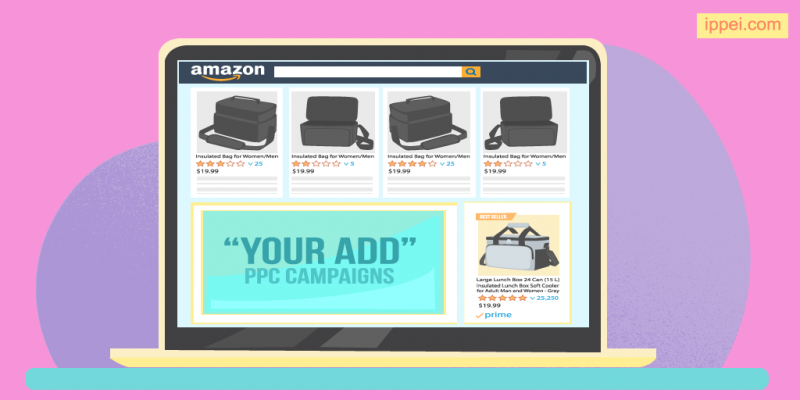
This Amazon PPC campaign will have access to lower required bid amounts because Amazon charges less per bid when you are advertising outside your main category.
This strategy enjoys the simultaneous benefit of extending your product’s reach and awareness while doing so at more affordable bid prices.
Take Advantage of New Competition
When sellers first start selling on Amazon, the common advice is to start with an automatic campaign. Therefore, you know their advertisements are appearing somewhere.
If your product is more established and has adequate reviews, you can piggyback off of their advertisements by placing your Amazon Sponsored product ad onto their listing.
Customers are more likely to buy your product with some social proof over their new product with low reviews.
To target a new product, simply type a relevant search term for your product into the Amazon search bar and filter by new arrivals.
Take the ASINs of 5-10 products you believe you have the advantage over and set up an Amazon Sponsored product campaign with product targeting to show your PPC ad on those specific ASINs.
We suggest setting this up as 5-10 ASINs in an ad group, and only one ad group in the campaign.
Targeting in Spanish
If you are selling in the United States and only targeting search terms in English, you are missing out on the 13% of the population who speak Spanish and are likely using it when searching Amazon.
Even if you don’t speak Spanish, you likely have a Spanish friend who can assist you or you can always use Google Translate.
Although this strategy won’t produce positive results in all situations, by incorporating a small portion of your advertising budget to Spanish targeting, you may find an untapped market.
Conclusion
Amazon PPC advertising is incredibly powerful, but it is really only an amplifier for what is already there, your product listing page.
Before engaging in Amazon PPC advertising, you need to ensure your behind-the-scenes Amazon SEO is done well and that you optimize your Amazon product listing so that customers are likely to click that buy box.
Amazon PPC management teaches you valuable skills that expand your knowledge of being an Ecommerce business owner and digital marketing while fostering a deeper understanding of the products and markets you sell in.
Although you could just employ an Amazon PPC service to handle all of this for you, that is costly and you would miss out on obtaining the expertise that the grind of the process provides you.
By implementing the tips provided in this guide and having a little patience, you will be running a successful Amazon PPC campaign in no time!
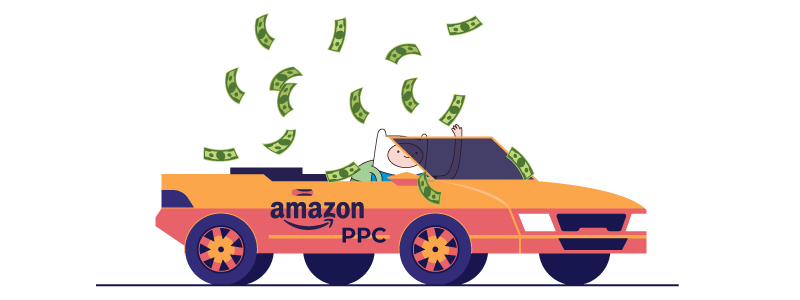


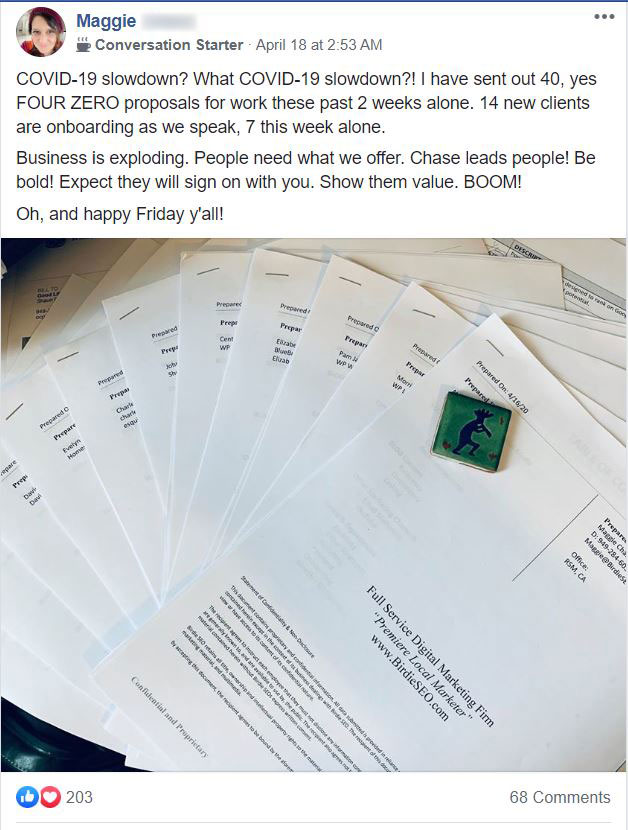
Great content. It will help the marketers to develop Amazon PPC strategy with the given actionable tips. They will boost their Amazon marketing. Thanks for sharing this content.
Great post. You've made Amazon PPC simple with this post. Would you say it's better than a Google Ads or Facebook Ads campaign?
Good question Randall and I don’t think there’s one concrete answer. For me my number one choice is lead generation. Other online business models will bring in cash, but in my personal experience, none have generated such a high semi-passive income as lead generation. If you’re ever curious or want to jump on a call feel free to book an appointment: https://ippei.com/coaching. Best o luck and thanks for reading and taking the time to comment.
Thanks Ippei and thanks for replying.
You’re welcome